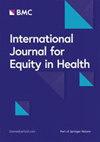埃塞俄比亚实施一揽子医疗保险福利的公平考虑因素:专家德尔菲活动的结果
IF 4.5
2区 医学
Q1 PUBLIC, ENVIRONMENTAL & OCCUPATIONAL HEALTH
引用次数: 0
摘要
效率、公平和财务风险保护是卫生系统的主要目标。公平分配医疗保健是埃塞俄比亚政府的优先战略举措之一。然而,埃塞俄比亚并没有关于干预措施收益分配的数据,也没有按亚人群分类的疾病负担数据来指导医疗保健优先事项的制定。根据政策文件,我们确定了埃塞俄比亚情况最差的以下群体:五岁以下儿童、育龄妇女、贫困人口和农村居民。我们使用德尔菲技术,由 28 位专家组成的专家小组在两天时间内分阶段对 253 种疾病/病症进行了评分。专家小组代表了不同的机构和专业组合。专家们给出了 1 至 4 分;其中 4 分表示主要影响穷人和农村居民的疾病/病症,1 分表示在富人和城市居民中更为普遍的疾病/病症。随后,计算出每种疾病/状况的平均公平得分。平均得分从 1.11(白癜风)到 3.79(产科瘘)不等。我们将得分标准化,使其介于 1 和 2 之间;1 代表最低公平得分,2 代表最高公平得分。然后将每种疾病/状况的得分分配给相应的干预措施。我们使用这些公平性得分来调整每个干预措施的 CEA 值。为了根据公平性调整 CEA 值,我们将每种干预措施的健康效益(成本效益值的分母)乘以相应的公平性得分,得出公平性调整后的 CEA 值。然后使用公平调整后的 CEA 值对干预措施进行排名。在没有关于疾病分布或次人口群体获得干预措施的分类数据的情况下,德尔菲法可用于生成公平分数,以确定卫生干预措施的优先次序。本文章由计算机程序翻译,如有差异,请以英文原文为准。
Equity considerations for the implementation of health insurance benefit package in Ethiopia: result of expert Delphi exercise
Efficiency, equity and financial risk protection are key health systems objectives. Equitable distribution of health care is among the priority strategic initiative of the government of Ethiopia. However, data on the distribution of interventions benefits or on disease burden disaggregated by subpopulations to guide health care priority setting is not available in Ethiopia. Aligned with policy documents, we identified the following groups to be the worse off in the Ethiopian context: under-five children, women of reproductive age, the poor, and rural residents. We used the Delphi technique by a panel of 28 experts to assign a score for 253 diseases/conditions over a period of two days, in phases. The expert panel represented different institutes and professional mix. Experts assigned a score 1 to 4; where 4 indicates disease/condition predominantly affecting the poor and rural residents and 1 indicates a condition more prevalent among the wealthy and urban residents. Subsequently, the average equity score was computed for each disease/condition. The average scores ranged from 1.11 (for vitiligo) to 3.79 (for obstetric fistula). We standardized the scores to be bounded between 1 and 2; 1 the lowest equity score and 2 the highest equity score. The scores for each disease/condition were then assigned to their corresponding interventions. We used these equity scores to adjust the CEA values for each of the interventions. To adjust the CEA values for equity, we multiplied the health benefits (the denominator of the cost-effectiveness value) of each intervention by the corresponding equity scores, resulting in equity adjusted CEA values. The equity adjusted CEA was then used to rank the interventions using a league table. The Delphi method can be useful in generating equity scores for prioritizing health interventions where disaggregated data on the distribution of diseases or access to interventions by subpopulation groups are not available.
求助全文
通过发布文献求助,成功后即可免费获取论文全文。
去求助
来源期刊

International Journal for Equity in Health
Medicine-Health Policy
CiteScore
7.80
自引率
4.20%
发文量
162
审稿时长
28 weeks
期刊介绍:
International Journal for Equity in Health is an Open Access, peer-reviewed, online journal presenting evidence relevant to the search for, and attainment of, equity in health across and within countries. International Journal for Equity in Health aims to improve the understanding of issues that influence the health of populations. This includes the discussion of political, policy-related, economic, social and health services-related influences, particularly with regard to systematic differences in distributions of one or more aspects of health in population groups defined demographically, geographically, or socially.
 求助内容:
求助内容: 应助结果提醒方式:
应助结果提醒方式:


